From Michelangelo's Sistine ceiling to an entire room dedicated to Henri Matisse, we have collected some of the art treasures that cannot be missed in the smallest state in the world, reports The Art Newspaper.
The Vatican is the smallest state on the planet, but it also boasts an amazing collection of works of art that the whole world can envy. Successive popes created an unsurpassed abundance of works of art, spending huge sums on paintings, frescoes, architecture and sculptures to demonstrate the enormous power of the church and consolidate their reputation in the annals of history. The Vatican's extensive museums include the Sistine Chapel, private papal apartments, and dozens of art collections including ancient sculpture, Renaissance masters, and contemporary art. About 20,000 works (from an extensive collection of 70,000 copies) are exhibited in approximately 1,400 halls, chapels and galleries. Here are our suggestions on what to see in the Vatican first.
Frescoes by Michelangelo (1508-1541), Sistine Chapel, Vatican Museum.

To date, the Sistine Chapel is considered the most famous chapel, which is located in the Vatican. The chapel was built in 1475 – 1481, its architect is the young master Giovanni de Dolci. This building was built during the reign of Sixtus IV, which is why the chapel has such a name.
The Sistine Chapel is a huge rectangular hall, which has an oval–shaped vault, and is divided into two parts by an incredibly beautiful marble fence. The architects have put a lot of work into the construction of such a building, but the most important value and wealth of the Sistine Chapel are the frescoes of Michelangelo and the wall bends, which can rightly be called the pinnacle of Renaissance art.
Michelangelo worked on the paintings of the chapel from 1508 to 1512. His craving for art was nowhere more revealed than in the images of the Prophets and Sibyls. The middle part of the vault is decorated with scenes from the Book of Genesis, among which the world-famous fresco The Creation of Man. Between the years 1536-1541 Michelangelo still returned to the Sistine Chapel, at that time Paul the Third Farnese ruled there. A new work of art by the master — the fresco of the Last Judgment occupies almost the entire wall of the chapel near the altar. To create it, I had to abandon work on several other frescoes. In the center of the circle Michelangelo makes a figure of Christ, who condemns earthly sinners. In the image of the fresco, he raised his right hand, as if he wanted to pronounce his terrible and indisputable verdict. Almost all fragments from the Bible are painted on the ceiling of the chapel.
Pieta Michelangelo (1497-1499), St. Peter's Cathedral.
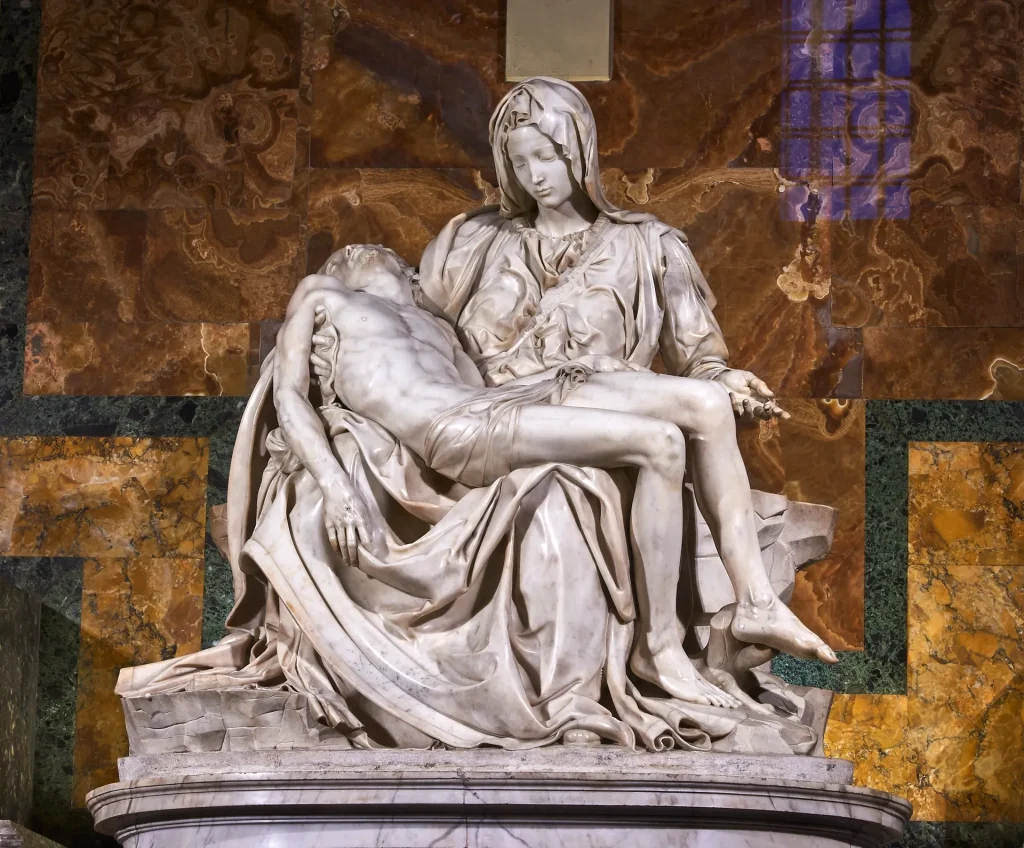
Michelangelo's Pieta is a mournful image of Mary mourning the crucified Christ taken from the cross. The masterpiece is on display in St. Peter's Cathedral in the Vatican. Translated from Italian, Pietà means "compassion, sorrow, pity, sympathy". The plot of this iconographic sculpture is not mentioned in the 4 texts of the Gospel, nor is it in the apocrypha. But in Catholicism, the Pieta of the great master is one of the most powerful images for influencing the minds and hearts of believers.
Michelangelo's Pieta is a pyramid–shaped sculptural composition carved from a single block of light marble. The master's hand cut off everything superfluous, and a stunning image of a grieving mother who lost her son appeared to the world. The sculpture is behind armored glass, it cannot be viewed from all sides. But there is something in it that attracts the curious gazes of tourists and generates special feelings among those who believe in the atoning sacrifice of Jesus Christ.
The work was protracted and painstaking, few people believed that an unknown 24-year-old artist and novice sculptor would cope with such a task. But the result exceeded all expectations – no one could surpass this masterpiece of Michelangelo, both in aesthetics and in the power of emotional embodiment.
"The Burial of Christ" by Caravaggio (circa 1600-1604), Vatican Pinacoteca, Vatican Museums.

In the Vatican, the eyes of numerous pilgrims are presented with an illustration of the biblical plot "The Burial of Christ" (canvas 300 x 203 cm, painted in 1602-1603). This composition was subsequently copied by many followers of Caravaggio, it is also known as "The Position in the tomb of Christ". He was taken down from the cross and laid in a cave intended as a place for burial.
One of the masterpieces of the great painter, which is kept in the Vatican Pinacoteca, was originally painted for the Chiesa Nuova church. The composition impresses with the depth of the tragedy of the central scene of the Gospel – about the crucifixion of the Savior and his burial before His miraculous resurrection. Jesus died on the cross for the sins of all mankind, becoming a perfect atoning sacrifice to God. One of the strongest manifestations of tragedy in the realistic canvases of the master. Being an unmistakable example of Caravaggio's unique Baroque style, the painting is also imbued with High Renaissance, with the clear influence of Michelangelo's "Pieta" and Raphael's "Displacement" (1507).
Van Gogh's Pieta (circa 1890), Collection of Modern Art, Vatican Museums.
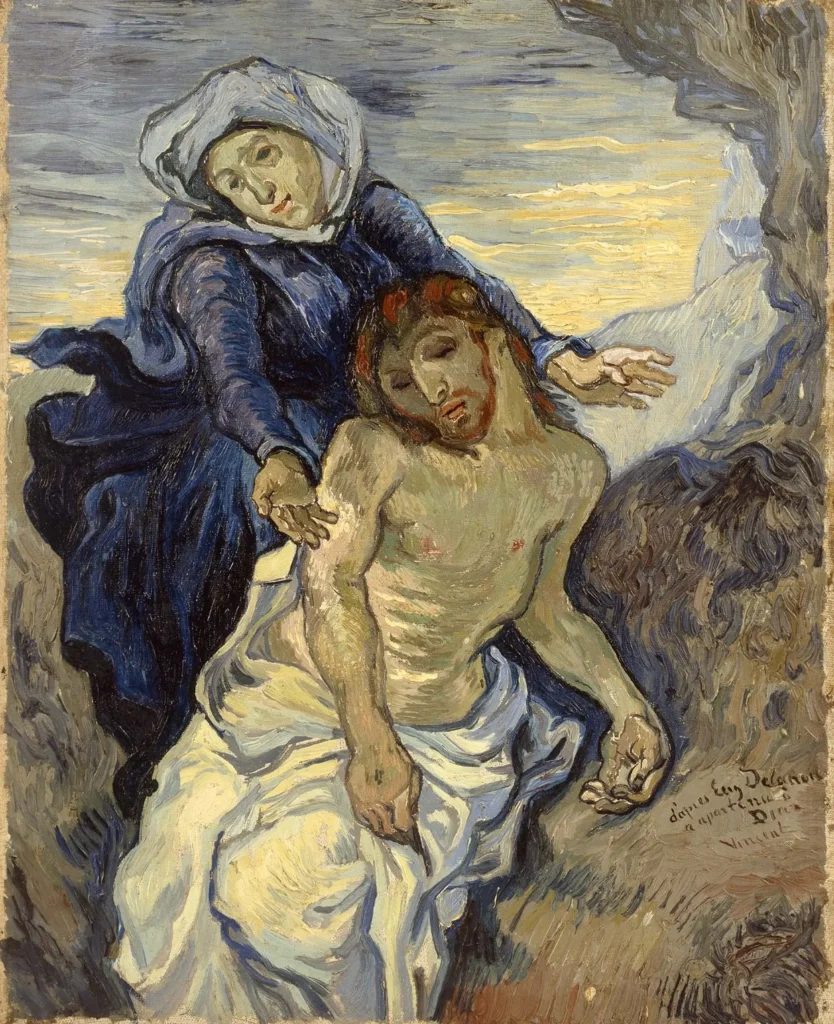
Van Gogh wrote this work just a few months before his suicide. Some suggest that the lifeless bearded figure of Christ is a kind of self-portrait. Inspired by Delocroix's own version of the same theme, the work takes pride of place in the 55 rooms of the Borgia apartment, which houses a Collection of Modern Art, opened in 1973 after Pope Paul VI declared that the Church had distanced itself from modern art. The Madonna raises her hands forward, mournfully presenting the passion of Christ to the world. A larger and brighter version of the Pieta is on display at the Van Gogh Museum in Amsterdam.
Augustus de Prima Porta (first century AD), Chiaramonti Museum, Vatican Museum.
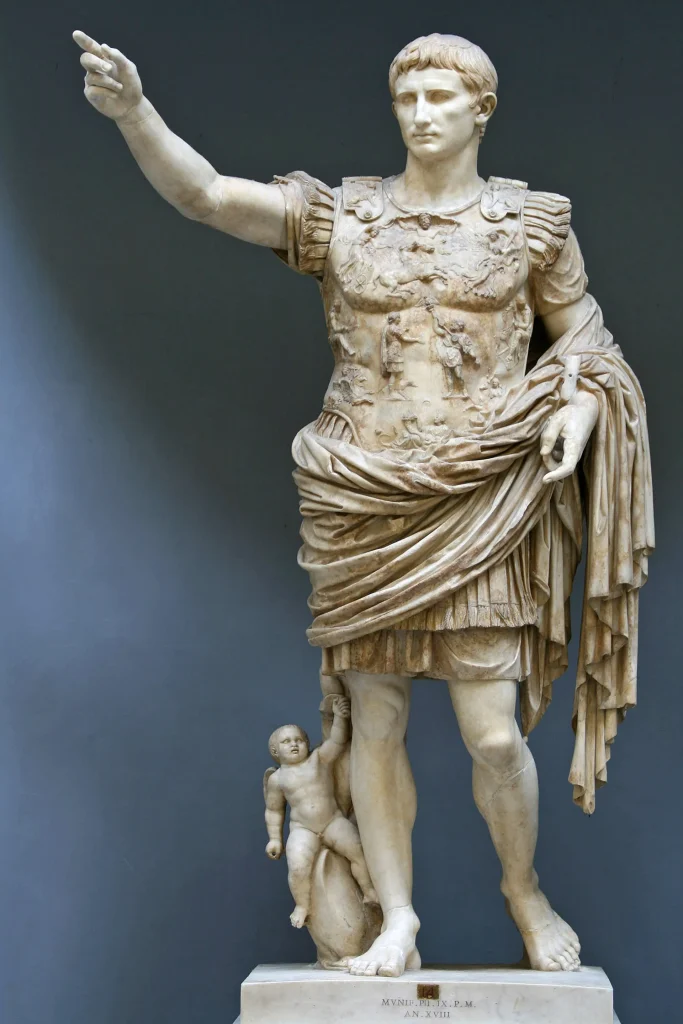
This iconic sculpture of Augustus Caesar, the first emperor of the Roman Empire, is one of the most famous works of art of the ancient world. The original full-length work, carved by experienced Greek sculptors, depicts Augustus addressing his troops in the classic adlocutio pose. His breastplate is richly decorated with reliefs of the Parthian king and a cosmic landscape depicting the goddess Diana, the chariots of Apollo and Aurora, the goddess of the Earth.
Laocoon and his sons (circa 40-30 BC), Chiaramonti Museum, Vatican Museum.
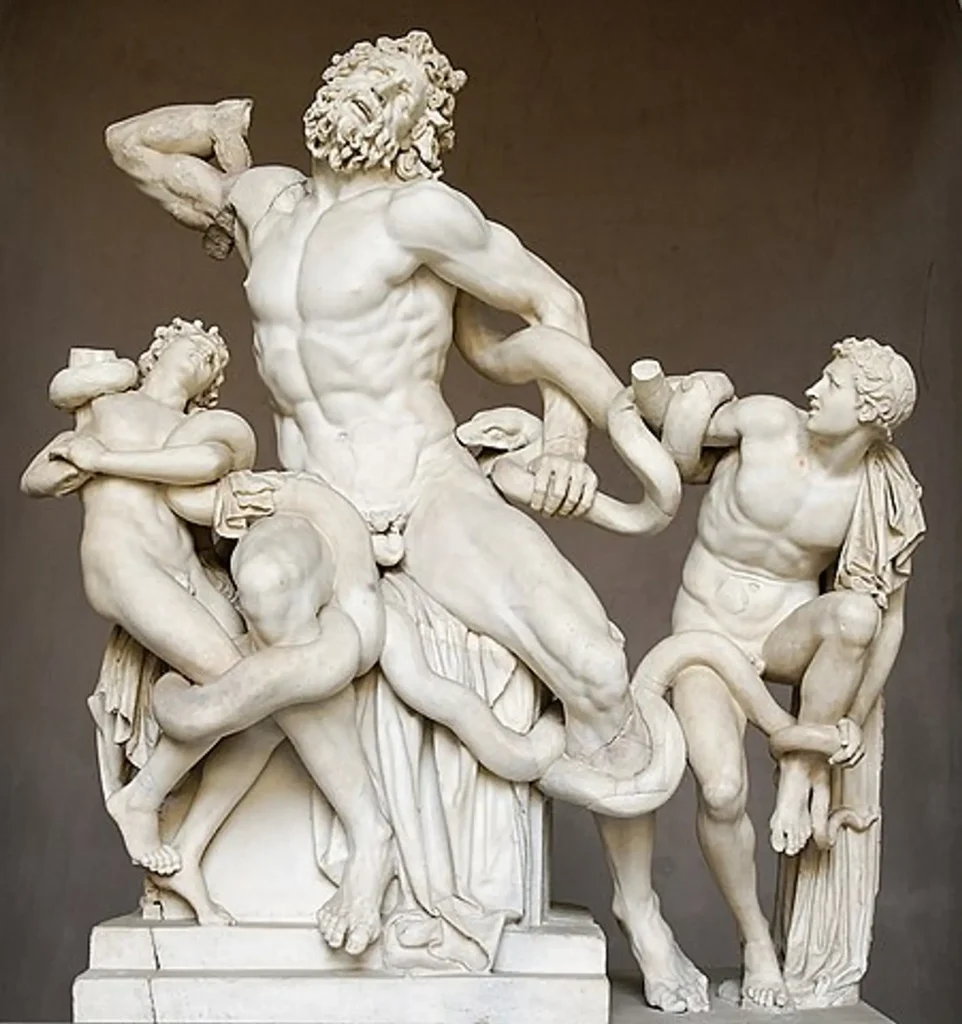
On January 14, 1506, the Italian Felice de Fredis, digging up his vineyard in the vicinity of Rome, unexpectedly discovered an underground cave. Examining it, he found there an amazing sculptural group depicting the legendary Trojan priest Laocoon with his sons.
As the Greek myth says, the Trojan priest of the god Apollo Laocoon advised his fellow citizens not to introduce a wooden horse into the city, in which the conquering warriors hid. But the Trojans did not heed his prediction and were defeated.
And the angry gods, at whose behest Troy was captured, betrayed the daring priest and his sons to a terrible execution: they were strangled by snakes. The death struggle of Laocoon and his sons is depicted by a sculptural group.
The masterpiece found by de Fredis was discovered on the site of the Golden House, which was built after 64 AD and was the residence of the Roman emperor Nero. The authors of this sculpture were Greek sculptors from Rhodes — Agesander, Polydorus and Athenodorus. The composition created by them is an exact marble copy of the second half of the I century BC from the original, which was made in bronze in 200 BC in Pergamon and has not been preserved.
Raphael School of Athens (1509-1511), Raphael Rooms, Vatican Museum.
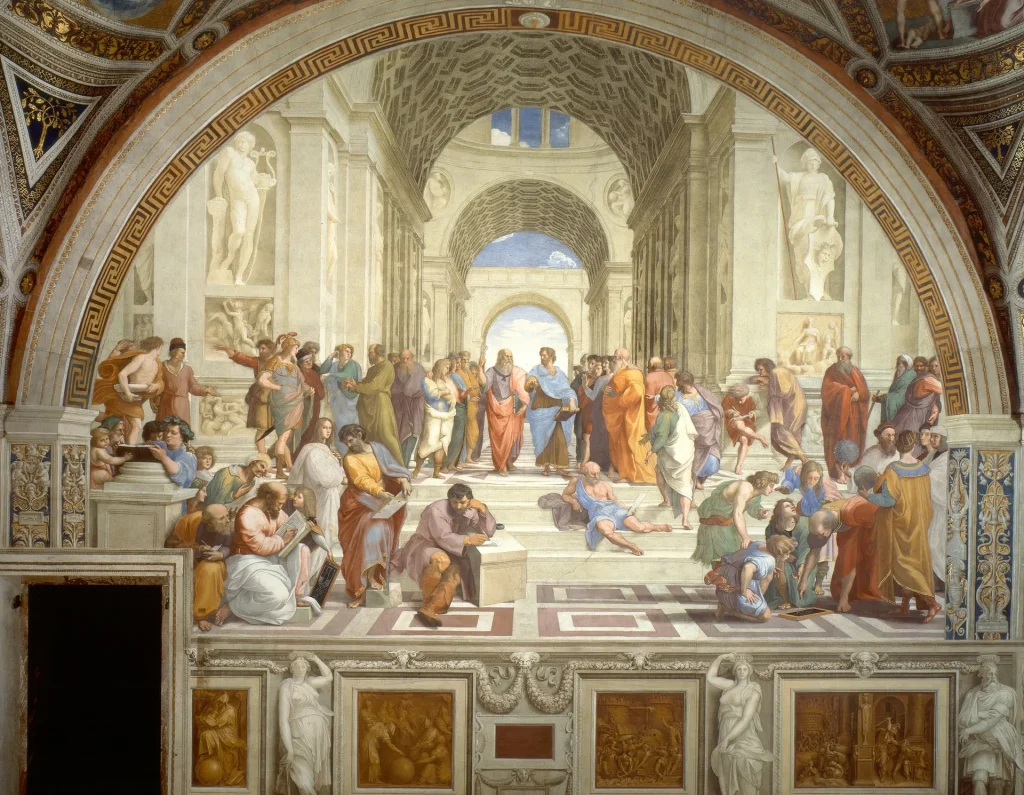
Raphael depicted a fantastic temple, the main nave of which goes into the blue distance with a row of vaulted arches, and placed ancient philosophers and scientists in its space. In the center, Plato is depicted pointing to the sky, which, as he believed, defines all human life, and Aristotle, stretching his hand over the earth. To the left, actively gesticulating, Socrates explains something to the students with a steep, stubborn forehead, below Pythagoras writes in a book where those sitting around him look with curiosity, Heraclitus of Ephesus froze with a pen in his hand, immersed in his thoughts, Diogenes reclines in a relaxed pose on the marble steps, to the right, bending over the tablet, writes Archimedes has his formulas, Strabo and Claudius Ptolemy are talking behind him. In the last group, Raphael depicted the ancient Greek painter Apelles in a dark cap, looking at the viewer, giving him his own features.
On this fresco you can find other portraits of the artist's contemporaries: Plato resembles Leonardo da Vinci, and Heraclitus resembles Michelangelo, and they are painted in the manner of each of these masters. The figure of the first is harmonious, like da Vinci's paintings, it is balanced and enclosed in an invisible oval, and the face expresses calm. The second one is sitting in a complex, "twisted" pose, the burning of restless thoughts is felt in him, his appearance refers the viewer's imagination to the huge fresco that Michelangelo created in the Sistine Chapel at that time: this figure resembles the prophets from the ceiling.Gorenje. Thus, Raphael seemed to wink at his eternal rival, once again emphasizing how strong the world brotherhood of artists is.
The Transfiguration of Raphael (1516-1520), Vatican Pinacoteca, Vatican Museum.
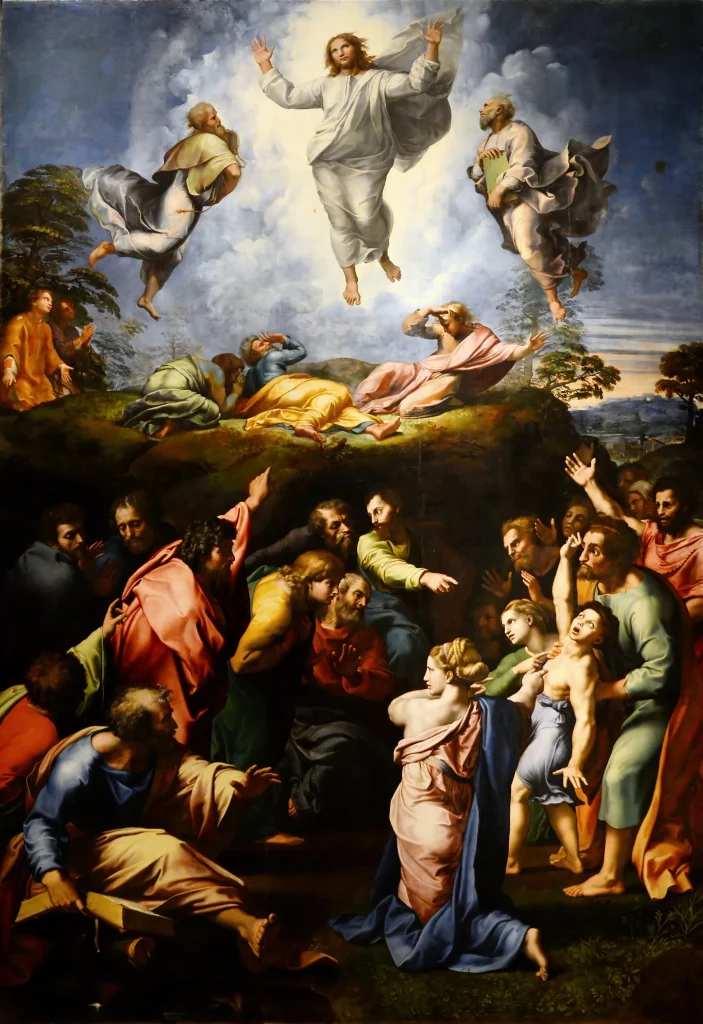
Raphael's latest work, which art historian Giorgio Vasari called "the most famous, the most beautiful and the most divine", marks the culmination of the artist's work. The painting combines two plots from the book of Matthew in an allegorical juxtaposition of human shortcomings and divine redemptive power. The upper part depicts the transfigured Christ towering in front of billowing luminous clouds, with the prophets Moses and Elijah on both sides.
Matisse Room, Collection of Modern Art, Vatican Museum.

In 1947, Henri Matisse began work on the Chapel du Roseur in Vence on the French Riviera (his first and only religious work). He designed everything from stained glass windows to interior decoration, frescoes and vestments of priests. More than 60 years later, Pierre Matisse, the artist's son, donated Vance's plans, models and preparatory sketches to the Vatican. Visitors to the Matisse Special room in the Collection of Contemporary Religious Art can admire three full—size sketches of a bright stained glass window; in which green represents vegetation, yellow represents the sun, and blue represents the Mediterranean Sea. Also on display are a drawing of the Virgin and Child, conceived for the white ceramic panels of the chapel, a bronze casting of the altar cross and five silk chasubles.
Frescoes by Fra Angelico (1447-1451), Nikolin Chapel, Vatican Museum.
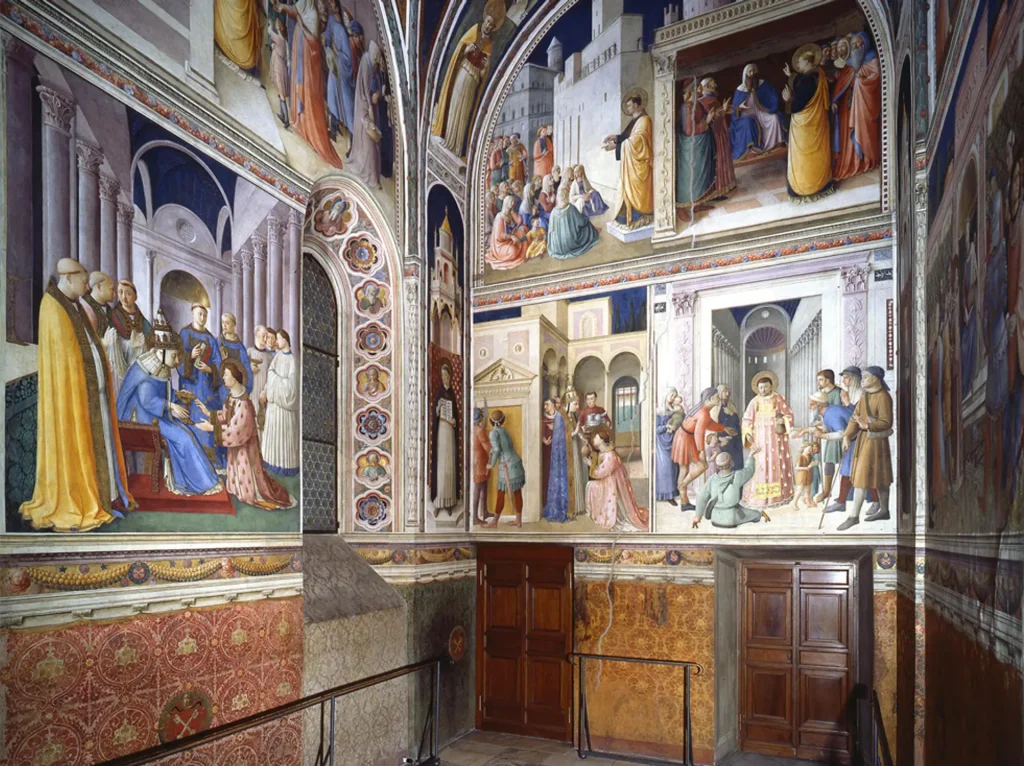
Visitors passing from Raphael's Rooms to the Chiaroscuro Hall often miss a small doorway to the Niccolina Chapel, which was once the private chapel of Nicholas V (Pope from 1447 to 1455). The chapel is decorated with beautifully preserved frescoes by Fra Angelico — a devout Florentine monk and early Renaissance artist — depicting the life and martyrdom of Saints Stephen and St. Lawrence. The beautiful architectural details in the background hint at Nicholas V's desire to restore Rome as the new capital of Christianity.





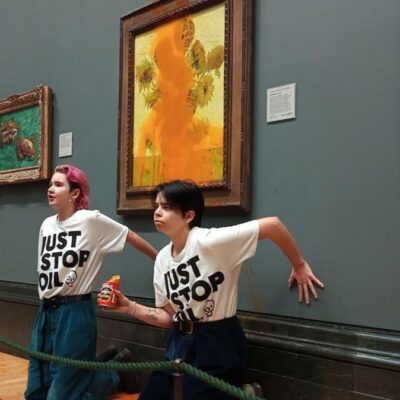
Say goodbye to anxiety: Nastya Zharko's solo exhibition "S.O.S EXHIBITION"
Для меня любовь это - искусство: Лейла Махат о своей персональной выставке "About Love. Leyla"